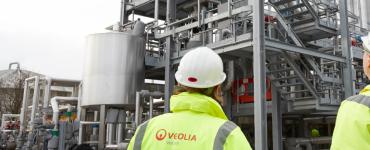- Home
- Latest News
- In full flow: Totex is finally taking effect in the water sector

In full flow: Totex is finally taking effect in the water sector
A sector once seen as slow moving and traditional is now in its most dynamic period for decades. Totex, legislative changes, skills shortages and, inevitably, Brexit are all contributing to new approaches to process and working culture, reports Brian Attwood.
At the risk of stating the blindingly obvious, the last month has not been a good one for the water and wastewater management sector.
A £20 million bill for fines and costs was imposed in March upon Thames Water for a series of incidents in which huge volumes of untreated sewage were deposited along the Thames and its tributaries.
Those cardinal errors were committed, however, three to four years ago, and it is a very different environment that will be on show at, for example, the annual Pump Centre conference in May that draws together key elements of the supply chain.
The theme – could it be anything else? – will be Totex, a word that has become as ubiquitous in the water industry as Brexit is in the wider economy.
The term made its appearance thanks to Ofgem in 2008, before kicking into play seven years later during the first year of Asset Management Programme AMP6.
Yet as Veolia Water Technologies’ business development director Michael Froom points out, so far there have been more words than actions: “My initial observation is that, while the regulator made provision for early stage programmes, the reality at the beginning of AMP6 has been pretty slow – not just with the introduction of Totex, but also the concept of an outcomebased approach rather than an output-based one.”
Now at the effective start of the third year, says Froom, work is coming through and one might expect a “bow wave” of activity during the next two years.
What is certain is that Totex – the total expenditure planning model that encompasses capital expenditure (Capex) with operational costs (Opex) – ought to encourage much greater focus on energy use and maintenance.
Much is made of the emphasis on maintenance and prolonging asset life as an antidote to spending on new products and works. Better management, in short, of what one already has.
However, even if the water companies have Totex to the forefront, it cannot be assumed this will filter down beyond Tier 1, where contractors are likely to be addressing cost rather than asset value.
Better communication
Yet some suppliers are noticing a positive trend says Barry Hopton, municipal business manager at atg UV Technology: “Water companies now engage directly with suppliers at the development stage to help allow them to communicate their requirements early on in the design of the product.
“Suppliers are now able to concentrate on long-term innovation towards reducing Totex costs that are aligned with the water companies’ long-term budget and sustainability plans.”
Those companies, he adds, are also communicating regularly with the manufacturers to gain their input into a project or programme of works much earlier, rather than leaving it to the Tier 1 and 2 contractors.
Limited spend in the early AMP period may be attributable to the vagaries of the asset management cycle, its susceptibility to boom and bust, and the advisability of retaining reserves for unexpected demands on expenditure, reckons Stuart Minchin, divisional manager of water & environment and buildings for engineering recruiter Matchtech.
“The thinking is ‘why pump £200 million into this sector in year 1 when we don’t need to?’, when by year three there are upgrades and an ageing workforce to content with.”
The hope is of course that the Totex approach will smooth these fluctuations, but whether it will remains a matter also of time and company culture.
Much may depend, says Froom, on whether companies have rollover projects or whether projects are being conducted with new partners or longstanding ones who are “still very much Capex driven”.
Up to the job
The question, he says, is whether such models are fit for purpose in delivering a Totex and outcome-driven approach.
Hopton suggests this variation in approach has a significant effect on costs for Water Treatment Works (WTW): “Some water companies still believe in their standard asset specifications and will not deviate from these for any reason, even if several parties can clearly show that this standard is not applicable or required.
“These specifications can add significant Totex costs to a project; it does become very clear which water companies are more active in their approach to Totex when these specification scenarios arise. More active companies will review their specs and use a better risk-based approach to designing a plant.”
Veolia’s Froom acknowledges there are two schools of thought on the issue – on the one hand there are those who believe asset standards are driving efficiency, and on the other those who maintain that the same standards often stifle innovation because they are seen as barriers to innovation. There is, he insists, a place for both interpretations.
“I’m more optimistic now, having been in this industry for more than 20 years. There’s more willingness and openness now and a recognition that regulation and innovation should be complementary,” he states, adding that outcome-based regulation allows greater scope for innovation than an output-based solution.
Incremental changes such as those based on predictive analysis, the use of greases and biodiesel and enhancement of sludge treatment mean “we’re pushing the boundaries of wastewater treatment”.
Interest in the uses of pyrolysis is also growing, says Froom. It is reported that the global market for biochar – the high carbon residue developed from the thermal decomposition of biomass – will have rocketed from $260 million to $585 million in the period 2015-2020 [Zion research].
US company BioForceTech recently claimed its two-phased use of Biodryers and pyrolysis allowed it to process biosolids in a thirtieth of the space required for spread and heat drying techniques and reduced the volume to 8% of the original biomass.
In general, warns Froom, proper testing is needed to ensure any risk is well calculated: “There’s a lot that isn’t really innovation. [We need to ask] is it really innovation? Has it been used elsewhere, do we really know the lessons learned elsewhere?
“The game changing stuff will be data – how we harness it to drive efficiency.”
For a supplier such as Hopton, the ‘innovation’ that counts most is DfMA – Design for Manufacture and Assembly [a DfMA pre-fabricated UV skid used for treating lake water is pictured above].
The concept – design with fewer but multi-functional parts and easier assembly – isn’t new. Yet Totex has provided the catalyst for its extension, says Hopton.
“The concept has definitely been around for a long time and has been implemented well by some water companies, whereas others are only now understanding and using this methodology to reduce Totex.”
Both Minchin and Froom acknowledge that these are interesting times for a sector once characterised as slow-moving or inert.
“We are now in the most dynamic period for 25 years,” says Froom, citing besides Totex the Water 2020 reforms, the opening of the sewage sludge market, and changes to domestic retail.
To which can be added the knock-on effect of Brexit and the two-year withdrawal process recently triggered by Article 50, which will coincide all too neatly with the next AMP period.
“If we haven’t got trade deals in place, if we haven’t got procurement deals in place…three years can go pretty quickly,” warns Minchin.













